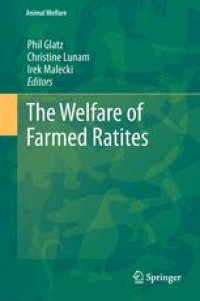
Ebook: The Welfare of Farmed Ratites
- Tags: Zoology, Fish & Wildlife Biology & Management, Animal Ecology, Agriculture
- Series: Animal Welfare 11
- Year: 2011
- Publisher: Springer-Verlag Berlin Heidelberg
- Edition: 1
- Language: English
- pdf
This volume reviews, for the first time, the broad range of issues that affect the welfare of commercially farmed ratites. Although ratites incorporate several families of flightless birds this book focuses on the most commonly farmed ratites, the ostrich, emu and rhea. The readers are taken on a journey through all sectors of the industry, which include breeding, incubation, hatching, brooding, rearing, growth, transport and processing, with an emphasis on husbandry and management protocols that can impact bird welfare and health. Also discussed is the structure and sensory innervation of the skin and digits of the birds, and the potential welfare implications of industry practices on these structures. Each chapter in this volume focuses on a particular aspect of the commercial farming of ratites with contributing authors from a broad range of disciplines.
This volume reviews, for the first time, the broad range of issues that affect the welfare of commercially farmed ratites. Although ratites incorporate several families of flightless birds this book focuses on the most commonly farmed ratites, the ostrich, emu and rhea. The readers are taken on a journey through all sectors of the industry, which include breeding, incubation, hatching, brooding, rearing, growth, transport and processing, with an emphasis on husbandry and management protocols that can impact bird welfare and health. Also discussed is the structure and sensory innervation of the skin and digits of the birds, and the potential welfare implications of industry practices on these structures. Each chapter in this volume focuses on a particular aspect of the commercial farming of ratites with contributing authors from a broad range of disciplines.
This volume reviews, for the first time, the broad range of issues that affect the welfare of commercially farmed ratites. Although ratites incorporate several families of flightless birds this book focuses on the most commonly farmed ratites, the ostrich, emu and rhea. The readers are taken on a journey through all sectors of the industry, which include breeding, incubation, hatching, brooding, rearing, growth, transport and processing, with an emphasis on husbandry and management protocols that can impact bird welfare and health. Also discussed is the structure and sensory innervation of the skin and digits of the birds, and the potential welfare implications of industry practices on these structures. Each chapter in this volume focuses on a particular aspect of the commercial farming of ratites with contributing authors from a broad range of disciplines.
Content:
Front Matter....Pages i-xvii
The Ethics of Farming Flightless Birds....Pages 1-11
Breeder Welfare: The Past, Present and Future....Pages 13-43
Natural Mating and Artificial Insemination....Pages 45-63
Incubation and Chick Rearing....Pages 65-89
Ostrich Nutrition and Welfare....Pages 91-109
Welfare Issues Associated with Ratite Husbandry Practices....Pages 111-130
The Structure and Sensory Innervation of the Integument of Ratites....Pages 131-145
Ratite Movement....Pages 147-164
Ratite Health: Welfare Implications....Pages 165-194
Bird Handling, Transportation, Lairage, and Slaughter: Implications for Bird Welfare and Meat Quality....Pages 195-235
Ratite Conservation: Linking Captive-Release and Welfare....Pages 237-258
Back Matter....Pages 259-163
This volume reviews, for the first time, the broad range of issues that affect the welfare of commercially farmed ratites. Although ratites incorporate several families of flightless birds this book focuses on the most commonly farmed ratites, the ostrich, emu and rhea. The readers are taken on a journey through all sectors of the industry, which include breeding, incubation, hatching, brooding, rearing, growth, transport and processing, with an emphasis on husbandry and management protocols that can impact bird welfare and health. Also discussed is the structure and sensory innervation of the skin and digits of the birds, and the potential welfare implications of industry practices on these structures. Each chapter in this volume focuses on a particular aspect of the commercial farming of ratites with contributing authors from a broad range of disciplines.
Content:
Front Matter....Pages i-xvii
The Ethics of Farming Flightless Birds....Pages 1-11
Breeder Welfare: The Past, Present and Future....Pages 13-43
Natural Mating and Artificial Insemination....Pages 45-63
Incubation and Chick Rearing....Pages 65-89
Ostrich Nutrition and Welfare....Pages 91-109
Welfare Issues Associated with Ratite Husbandry Practices....Pages 111-130
The Structure and Sensory Innervation of the Integument of Ratites....Pages 131-145
Ratite Movement....Pages 147-164
Ratite Health: Welfare Implications....Pages 165-194
Bird Handling, Transportation, Lairage, and Slaughter: Implications for Bird Welfare and Meat Quality....Pages 195-235
Ratite Conservation: Linking Captive-Release and Welfare....Pages 237-258
Back Matter....Pages 259-163
....